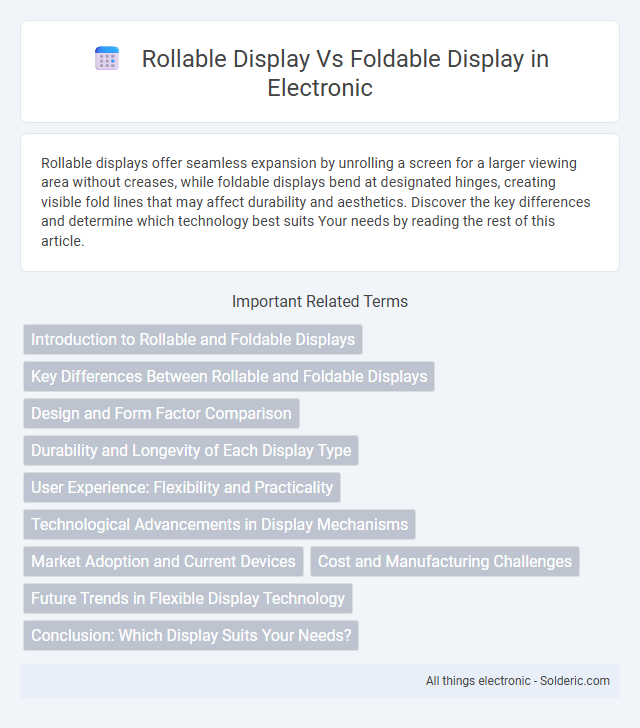Rollable displays offer seamless expansion by unrolling a screen for a larger viewing area without creases, while foldable displays bend at designated hinges, creating visible fold lines that may affect durability and aesthetics. Discover the key differences and determine which technology best suits Your needs by reading the rest of this article.
Comparison Table
| Feature | Rollable Display | Foldable Display |
|---|---|---|
| Design | Flexible OLED that rolls into a compact tube | Flexible OLED that folds along a hinge |
| Durability | Less prone to crease, better longevity | May develop visible fold creases over time |
| Thickness When Closed | Thinner, as screen rolls inside | Thicker due to more layers folding |
| Screen Size | Expandable continuously within range | Limited by foldable joints, fixed sizes |
| Use Cases | Phones, tablets, TVs with variable screen sizes | Smartphones, foldable laptops, tablets |
| Market Availability | Emerging, less commercial products | Established, multiple available devices |
| Price | Higher due to advanced tech and rarity | Lower, more mature production |
Introduction to Rollable and Foldable Displays
Rollable displays utilize flexible OLED technology to extend screen size by unrolling, offering seamless expansion without visible folds, while foldable displays incorporate hinge mechanisms allowing screens to bend inward or outward, creating compact devices with distinct crease lines. Both leverage advanced materials like polyimide substrates for durability and ultra-thin glass for enhanced touch sensitivity, driving innovation in smartphones and tablets. Rollable displays present smoother, uninterrupted viewing surfaces, whereas foldable displays prioritize portability and device versatility.
Key Differences Between Rollable and Foldable Displays
Rollable displays unroll smoothly from a rigid case, offering a flexible screen expansion without visible creases, while foldable displays hinge at a central point, allowing the device to fold like a book but often showing a crease along the fold line. Rollable screens maximize uninterrupted screen space and durability by eliminating folding stress, whereas foldable displays emphasize compactness and portability by physically reducing device size. Understanding these key differences helps you choose the ideal technology based on your preference for screen smoothness or device compactness.
Design and Form Factor Comparison
Rollable displays offer a sleek, cylindrical design that expands horizontally, allowing devices to transform from compact to larger screens without visible creases. Foldable displays hinge along a defined axis, enabling devices to fold vertically or horizontally but often show a noticeable crease at the fold line. Your choice depends on whether you prioritize seamless screen integrity and minimalistic form (rollable) or a familiar, book-like folding experience (foldable).
Durability and Longevity of Each Display Type
Rollable displays generally offer enhanced durability compared to foldable displays due to their seamless design that eliminates creases and reduces mechanical stress during use. Foldable displays often face challenges with hinge mechanisms and visible crease wear over time, which can compromise longevity. Advances in materials like ultra-thin glass and reinforced polymers are improving both technologies, but rollable displays currently lead in minimizing structural fatigue and extending device lifespan.
User Experience: Flexibility and Practicality
Rollable displays offer seamless expansion of screen size without visible creases, enhancing your user experience by providing a smooth and uninterrupted viewing surface. Foldable displays, while compact and portable, tend to develop noticeable folds that may affect touch sensitivity and durability over time. The practical advantage of rollable technology lies in its ability to adapt dynamically to different usage scenarios, giving you flexible screen real estate without compromising the device's structure.
Technological Advancements in Display Mechanisms
Rollable displays utilize flexible OLED technology that allows screens to extend and retract smoothly, offering a seamless user experience without visible creases. Foldable displays rely on hinge mechanisms combined with ultra-thin glass or plastic substrates, enabling devices to fold along a defined axis but often face challenges with durability and crease visibility. Recent advancements in polymer substrates and hinge engineering have significantly enhanced both rollable and foldable displays, pushing the boundaries of portability and screen innovation in consumer electronics.
Market Adoption and Current Devices
Foldable displays have seen broader market adoption with devices like the Samsung Galaxy Z Fold series and Huawei Mate X series leading mainstream availability, offering consumers familiar smartphone form factors with flexible screens. Rollable displays remain niche, with limited commercial releases such as the LG Rollable and Oppo X 2021 showcasing innovative expansion capabilities but lacking widespread consumer traction. Your choice depends on whether you prioritize proven durability and app ecosystem support in foldables or cutting-edge design with potential future versatility in rollables.
Cost and Manufacturing Challenges
Rollable displays face higher manufacturing complexity and cost due to the need for flexible materials that withstand continuous rolling without damage. Foldable displays, while also expensive, benefit from more established production processes but require durable hinge mechanisms to avoid screen creasing and mechanical wear. Your choice between rollable and foldable technology depends on balancing innovation with budget constraints and manufacturing reliability.
Future Trends in Flexible Display Technology
Rollable displays offer seamless expansion and a more compact form factor compared to foldable displays, which rely on creases and hinges that can impact durability and design flexibility. Future trends in flexible display technology emphasize improvements in materials such as ultra-thin glass and advanced polymers, enabling higher durability, enhanced user experience, and new device form factors. Your choice between rollable and foldable devices will increasingly depend on innovations in sensor integration, battery technology, and screen flexibility that drive practical usability and market adoption.
Conclusion: Which Display Suits Your Needs?
Rollable displays offer seamless expansion and a sleek, uninterrupted screen ideal for users prioritizing portability and futuristic design, while foldable displays provide familiar smartphone usability with enhanced multitasking through dual-screen functions. Your choice depends on whether you value compactness and continuous viewing or prefer practicality with established tactile interactions. Assessing your daily usage patterns and device handling preferences ensures selecting the display technology that best suits your lifestyle.
Rollable Display vs Foldable Display Infographic

 solderic.com
solderic.com